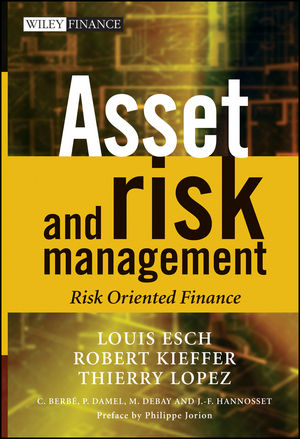Asset and Risk Management: Risk Oriented FinanceISBN: 978-0-471-49144-6
Hardcover
392 pages
March 2005
 This is a Print-on-Demand title. It will be printed specifically to fill your order. Please allow an additional 15-20 days delivery time. The book is not returnable.
|
||||||
Foreword by Philippe Jorion.
Acknowledgements.
Introduction.
Areas covered.
Who is this book for?
PART I: THE MASSIVE CHANGES IN THE WORLD OF FINANCE.
Introduction.
1 The Regulatory Context
1.1 Precautionary surveillance.
1.2 The Basle Committee.
1.2.1 General information.
1.2.2 Basle II and the philosophy of operational risk.
1.3 Accounting standards.
2 Changes in Financial Risk Management.
2.1 Definitions.
2.2 Changes in financial risk management.
2.3 A new risk-return world.
PART II: EVALUATING FINANCIAL ASSETS.
Introduction
3 Equities.
3.1 The basics.
3.2 Portfolio diversification and management.
3.3 Model of financial asset equilibrium and applications.
3.4 Equity dynamic models.
4 Bonds.
4.1 Characteristics and valuation.
4.2 Bonds and financial risk.
4.3 Deterministic structure of interest rates.
4.4 Bond portfolio management strategies.
4.5 Stochastic bond dynamic models.
5 Options.
5.1 Definitions.
5.2 Value of an option.
5.3 Valuation models.
5.4 Strategies on options.
PART III: GENERAL THEORY OF VaR.
Introduction.
6 Theoryof VaR.
6.1 The concept of ‘risk per share’.
6.2 VaR for a single asset.
6.3 VaR for a portfolio.
7 VaR Estimation Techniques.
7.1 General questions in estimating VaR.
7.2 Estimated variance–covariance matrix method.
7.3 Monte Carlo simulation.
7.4 Historical simulation.
7.5 Advantages and drawbacks.
8 Setting Up a VaR Methodology.
8.1 Putting together the database.
8.2 Calculations.
8.3 The normality hypothesis.-
PART IV: FROM RISK MANAGEMENT TO ASSET MANAGEMENT.
Introduction.
9 Portfolio Risk Management.
9.1 General principles.
9.2 Portfolio risk management method.
10 Optimising the Global Portfolio via VaR.
10.1 Taking account of VaR in Sharpe’s simple index method.
10.2 Taking account of VaR in the EGP method.
10.3 Optimising a global portfolio via VaR.
11 Institutional Management: APT Applied to Investment Funds.
11.1 Absolute global risk.
11.2 Relative global risk/tracking error.
11.3 Relative fund risk vs. benchmark abacus.
11.4 Allocation of systematic risk.
11.5 Allocation of performance level.
11.6 Gross performance level and risk withdrawal.
11.7 Analysis of style.
PART V: FROM RISK MANAGEMENT TO ASSET AND LIABILITY MANAGEMENT.
Introduction.
12 Techniques for Measuring Structural Risks in Balance Sheets.
12.1 Tools for structural risk analysis in asset and liability management.
12.2 Simulations.
12.3 Using VaR in ALM.
12.4 Repricing schedules (modelling of contracts with floating rates).
12.5 Replicating portfolios.
APPENDICES.
Appendix 1: Mathematical Concepts.
1.1 Functions of one variable.
1.2 Functions of several variables.
1.3 Matrix calculus.
Appendix 2: Probabilistic Concepts.
2.1 Random variables.
2.2 Theoretical distributions.
2.3 Stochastic processes.
Appendix 3: Statistical Concepts.
3.1 Inferential statistics.
3.2 Regressions.
Appendix 4: Extreme Value Theory.
4.1 Exact result.
4.2 Asymptotic results.
Appendix 5 Canonical Correlations.
5.1 Geometric presentation of the method.
5.2 Search for canonical characters.
Appendix 6: Algebraic Presentation of Logistic Regression.
Appendix 7: Time Series Models: ARCH-GARCH and EGARCH.
7.1 ARCH-GARCH models.
7.2 EGARCH models.
Appendix 8: Numerical Methods for Solving Nonlinear Equations.
8.1 General principles for iterative methods.
8.2 Principal methods.
8.3 Nonlinear equation systems.
Bibliography.
Index.



